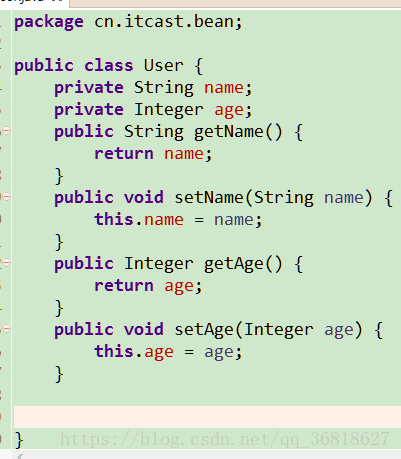Spring框架(一)---------基本配置
一.spring框架的配置一般姿势
1.导包
2.创建对象
3.配置文件(src/applicationContext.xml)
3.1 导入约束
3.2 配置applicationContext.xml文件
3.3测试用例
二.spring概念
1.IOC
2.DI
3.创建Bean工厂的两种方式
3.1 BeanFactory接口方式(了解,开发时不用),每次在获取对象时才会创建对象。
3.2 ApplicationContext 每次容器启动时就会创建容器中配置的所有对象。如果从类路径下加载配置文件使用ClassPathXmlApplicationContext("applicationContext.xml");如果从硬盘绝对路径下加载配置文件则使用FileSystemXmlApplicationContext("d:/xxx/xxx/xxx").
3.3 总结 :web开发中,使用applicationContext. 在资源匮乏的环境可以使用BeanFactory。
三.spring配置详解
1.scope属性
1.1 singleton(默认值):单例对象.被标识为单例的对象在spring容器中只会存在一个实例;
1.2 prototype:多例原型.被标识为多例的对象,每次再获得才会创建.每次创建都是新的对象.整合struts2时,ActionBean必须配置为多例的.
1.3 request:web环境下.对象与request生命周期一致.
1.4 session:web环境下,对象与session生命周期一致.
2.生命周期属性
public void init(){
System.out.println("生命周期属性之创建");
}
public void destroy(){
System.out.println("生命周期属性之销毁");
}3.spring创建对象的方式有三
3.1空参构造方式(配置同前面的测试用例此处不再赘述)
3.2静态工厂(了解)
UserFactory.java如下
public class UserFactory {
public static User creatUser(){
System.out.println("2.静态工程方式创建对象");
return new User();
}
}配置文件
![]()
测试方法
@Test
//1.静态工厂方式
public void fun2(){
//1.创建容器对象
ApplicationContext ac = new ClassPathXmlApplicationContext("com/auicyh/b_creat/applicationContext.xml");
//2.向容器要user对象
User user = (User) ac.getBean("user2");
//3.打印输出
System.out.println(user);
} 3.3实例工厂(了解)
UserFactory.java
public class UserFactory {
public User createUser2(){
System.out.println("实例工厂创建User");
return new User();
}
}配置文件
测试代码
//创建方式3:实例工厂
@Test
public void fun3(){
//1 创建容器对象
ApplicationContext ac = new ClassPathXmlApplicationContext("com/auicyh/b_creat/applicationContext.xml");
//2 向容器"要"user对象
User u = (User) ac.getBean("user3");
//3 打印user对象
System.out.println(u);
}4.sping的分模块配置
四.Spring属性注入的方式
1.set方法注入
User.java
package com.auicyh.bean;
public class User {
private String name;
private Integer age;
private Car car;
public Car getCar() {
return car;
}
public void setCar(Car car) {
this.car = car;
}
public User() {
System.out.println("1.无参构造方法");
}
public String getName() {
System.out.println("getName="+name);
return name;
}
public void setName(String name) {
System.out.println("setname="+name);
this.name = name;
}
public Integer getAge() {
return age;
}
public void setAge(Integer age) {
this.age = age;
}
public void init(){
System.out.println("生命周期属性之创建");
}
public void destroy(){
System.out.println("生命周期属性之销毁");
}
@Override
public String toString() {
return "User [name=" + name + ", age=" + age + ", car=" + car + "]";
}
}
Car.java
package com.auicyh.bean;
public class Car {
private String name;
private String color;
public String getName() {
return name;
}
public void setName(String name) {
this.name = name;
}
public String getColor() {
return color;
}
public void setColor(String color) {
this.color = color;
}
@Override
public String toString() {
return "Car [name=" + name + ", color=" + color + "]";
}
}配置文件applicationContext.xml
测试用例
测试结果
2.构造函数注入
构造函数配置
applicationContext.xml配置
测试类
测试结果
3.构造函数的特殊情况(如果有多个构造函数时,在配置文件中可以通过index和type属性来设置使用的是哪一个构造)
构造函数
applicationContext.xml配置
测试类
测试结果
4.p命名空间注入
applicationcontext.xml中需要导入p的命名空间
测试类和User类没有发生变化
测试结果 ------ 从测试结果可以看出p空间注入和set方式注入的机理是一样的。
5.SPEL表达式注入
配置文件
测试结果
6.复杂类型注入
CollectionBean.java
package com.auicyh.c_injection;
import java.util.Arrays;
import java.util.List;
import java.util.Map;
import java.util.Properties;
public class CollectionBean {
private Object[] arr;//数组类型注入
private List list;//list/set 类型注入
private Map map;//map类型注入
private Properties prop;//properties类型注入
public Object[] getArr() {
return arr;
}
public void setArr(Object[] arr) {
this.arr = arr;
}
public List getList() {
return list;
}
public void setList(List list) {
this.list = list;
}
public Map getMap() {
return map;
}
public void setMap(Map map) {
this.map = map;
}
public Properties getProp() {
return prop;
}
public void setProp(Properties prop) {
this.prop = prop;
}
@Override
public String toString() {
return "CollectionBean [arr=" + Arrays.toString(arr) + ", list=" + list + ", map=" + map + ", prop=" + prop
+ "]";
}
}配置文件applicationcontext.xml
tom
jim
com.jdbc.mysql.Driver
root
1234
测试类
测试结果
User( Car car,String name)
1.无参构造方法
setname=lucy
1.无参构造方法
getName=lucy
setname=lucy
CollectionBean [arr=[tom, jim, User [name=lucy, age=20, car=Car [name=劳斯兰斯, color=黑色]]], list=[jack, rose, User [name=lucy, age=20, car=Car [name=劳斯兰斯, color=黑色]]], map={url=jdbc:mysql:///crm, user=User [name=lucy, age=20, car=Car [name=劳斯兰斯, color=黑色]], Car [name=劳斯兰斯, color=黑色]=User [name=lucy, age=20, car=Car [name=劳斯兰斯, color=黑色]]}, prop={driverClass=com.jdbc.mysql.Driver, password=1234, userName=root}]



























